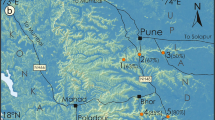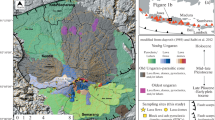Abstract
Jurassic Ferrar rocks in Victoria Land (Antarctica) occur predominantly as basaltic or andesitic flows and sills. Both show characteristic petrographical and chemical variations, which can be related to in-situ differentiation processes. Such characteristics have been investigated at one flow (“Colonnade flow”) and one sill (“Thumb Point sill”) in the Prince Albert Mountains (Central Victoria Land) based on a statistical grain size analysis and the application of the crystal size distribution theory. A third magma body (“HiTi-unit”), which in previous literature was described as a flow, does not show clear similarities to either the flow or sill. Sill and flow are in-situ differentiated with accumulation of silicic residual melt in the latest cooled parts. For the flow this part is located in the lower half and for the sill in the upper third of their thickness. Thumb Point sill additionally shows an accumulation zone of olivine in the lower third. The position of the residual melt accumulation zone is an indicator for an origin as flow or sill. The HiTi-unit, by contrast, exhibits, only moderate petrographical and chemical variations. Growth and nucleation rates have been determined using, with some modifications, the CSD theory introduced by Marsh (1988). Growth rates of plagioclase for the flow vary from 10−11 to 10−10 cm/s and are comparable with literature values for basaltic lava lakes on Hawaii. Nucleation rates vary from 10−4 to 10−3 cm−3s−1, which are generally smaller than for Hawaiian basalts. Growth and nucleation rates for the sill cover a large range from 10−13 to 10−11 cm/s and 10−9 to 10−3 cm−3s−1, respectively. Systematic variations of these parameters with vertical position were obtained for the sill with its extensive differentiation history. Nucleation and growth rates are dependant on the mode of cooling. Nevertheless, small but significant differences between the flow and sill exist. Growth and nucleation rates of HiTi-unit (10−12 to 10−11 cm/s and 10−6 to 10−5 cm−3s−1) are intermediate between the flow and sill and thus do not allow a distinction of emplacement mode.
Similar content being viewed by others
Author information
Authors and Affiliations
Additional information
Received: 6 December 1995 / Accepted: 3 May 1996
Rights and permissions
About this article
Cite this article
Wilhelm, S., Wörner, G. Crystal size distribution in Jurassic Ferrar flows and sills (Victoria Land, Antarctica): evidence for processes of cooling, nucleation, and crystallisation. Contrib Mineral Petrol 125, 1–15 (1996). https://doi.org/10.1007/s004100050202
Issue Date:
DOI: https://doi.org/10.1007/s004100050202




